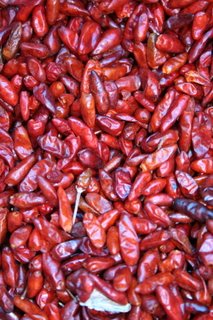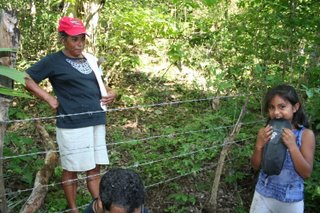 After working all last week with my Mexican collaborator, Jose (aka Pepe) on various aspects of the collecting, he and I took up the chase again, this time in the neighboring state of Queretaro. While Queretaro is not thought of as a prime wild chile habitat - much of the state is at higher altitudes and is heavily farmed, Pepe had an inside source - a former Master´s student - who knew of some areas where the wild chile roamed.
After working all last week with my Mexican collaborator, Jose (aka Pepe) on various aspects of the collecting, he and I took up the chase again, this time in the neighboring state of Queretaro. While Queretaro is not thought of as a prime wild chile habitat - much of the state is at higher altitudes and is heavily farmed, Pepe had an inside source - a former Master´s student - who knew of some areas where the wild chile roamed.
I´m happy to report to all of you that we collected from 4 populations and took samples from various local markets, some of which are pictured above. In contrast to previous chile hunts, in Queretaro the local wild chile is called "chile piquin" or "chil kipquin".
* Our first collection site was really significant. We were up in the folds of a mountain that rose up to 3500 m and were lost in tierras ejitidales (communal lands that are farmed), asking 4 or 5 folks for directions - follow that road (what road?) along the canal, take a left at the tree (which tree?) and just towards the mountain are the peppers, don´t worry, you´ll find them. After circling the same fields a few times, we contracted a 14 year old to take us to the plants - we went up a small embankment in the truck, followed the irrigation canal to the small lake where the road ended.
We drove around the lake to the other side to find the peppers in a high-altitude chapparral environment. What surprised us was the altitude - over 2000 meters in altitude, about 6700ft+. No one would think that wild peppers exist at this altitude. We continued to find the chile peppers under the same types of "nurse" plants - hackberry, mesquite and sometimes, cacti.
* We ended the first day in the small town of Bernal - at the base of a huge monolith that is thought channel spiritural energy. We ate the most amazing gorditas there - blue corn meal that is patted into the form of a tortilla, filled with shredded cheese and a chile sauce, heated on a hot comal, then filled with savory combinations - peppers with nopal and cheese, steak, more cheese and chile. One of the best street food stops so far. Pictures in the street food post to come.
*On the start of the following day, on our way to the far reaches of the state, Pepe says - this looks like a spot where peppers would grow, why wouldn´t they be here? So we stop and find a healthy population in the arroyo along the highway. Filled with self-confidence, we continue on. After reaching our destination, the municipio of Jalpan which is located on the fringes of the Huasteca forest that heads down to the Gulf of Mexico, we walk down an arroyo where we have been told there are plants. It is hot, humid, getting late and we do not see a single plant. We stumble across a machete wielding - grandmother (Margarita) and her grandaughter (Alicia) who are out looking for their lost goats. We ask them about the chile piquin plants and if they could help us. Margarita thinks its late to find plants in the far forest and most of the fruits are still green and they have to find their goats, and... I think then she took pity on us, 3 glasses-wearing, hot and sweaty city folk who were obviously lost in the forest. "But what about the ones you passed on your way here?" We didn´t see any the whole way and we were obviously looking for plants. She and Alicia proceed to walk with us back up the trail towards the road where we left the truck and point out about 10 plants - some of which were about an arm´s length from where we just walked! We had been looking for the bright red ripe fruit, which are easy to spot - these plants had no ripe fruits on them and were difficult to spot in the dense humid forest, a very different environment in which we had found the other populations. They had been picked over by birds and by people looking to add a bit of spice to their diets. We were extremely grateful and a bit sheepish as we accepted her help and catalogued the plants on the way up and tried to find the remaining ripe fruits for our study.
The sight of Doña Margarita wielding the machete and picking the plants out of the forest made me instantly smile, as I thought how generations of people must have harvested these fruits and how easily she recalled the locations of these plants. I was shaken out of this day-dream by the sandal-clad Margarita and her grandaughter Alicia, who had gathered a handful of green fruits and insisted that we take the immature green fruits for our salsa. And so we did and took our leave as we returned to the city of Queretaro.





1 comment:
Kraig and Heather,
What a great idea to keep us posted via a blog. I have been reading your entries for some time but did not have a chance to send you a comment: too much travel! I am finally home for a stretch. One of the trips was with Matthew to Jalisco to find teosinte and teosinte we saw. It is also home to wild beans.
It looks like you are filling up on seeds of wild peppers. Have fun and if you see Jose/Pepe, say hello from the lab.
Paul
Post a Comment